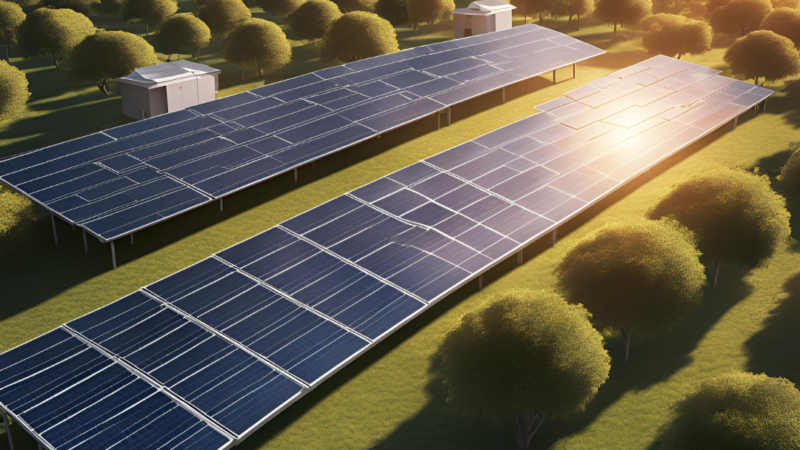¿Qué es una granja solar? Concepto, funcionamiento y tipos

In recent years, the transition to cleaner energy has promoted the development of renewable technologies. One of the most prominent for its efficiency, availability, and capacity for expansion is solar energy. And in this area, solar farms represent a solution increasingly used both industrially and communally.
But, what exactly is a solar farm? How does it work? What are its main advantages and how does it compare to other solar systems? In this article, we explain in detail these large-scale solar installations, so you understand the operation, benefits, types, costs, and some relevant examples in Spain and the world.
What is a solar farm?
A solar farm – also called a solar park, solar plant, or solar field – is a large photovoltaic installation that aims to capture solar radiation and convert it into electricity. These installations are characterized by occupying large lands or aquatic areas, and being composed of hundreds of interconnected solar panels.
Their main function is to generate large amounts of energy that can be used by industries, residential areas, and even sold to the general electricity grid. It is a clean, abundant, and efficient alternative compared to traditional energy sources that emit polluting gases or require extremely invasive processes.
The photovoltaic panels of these farms are strategically placed to maximize their exposure to the sun throughout the year. Unlike rooftop systems, a solar farm takes advantage of economies of scale to provide a much more cost-effective and significant energy production. To delve into this aspect, you can check out floating solar installations that have emerged as an innovative option.
How does a solar farm work?
The operating mechanism of a solar farm is similar to any photovoltaic system, but on a much larger scale. Solar energy is captured by solar panels composed of photovoltaic cells, usually silicon. These cells transform direct sunlight into electricity in the form of direct current.
This electricity then passes through solar inverters that convert DC into alternating current, suitable for conventional consumption. Additionally, there are battery storage systems that allow saving surplus energy for use when there is no sunlight, such as at night or on cloudy days. If you want more information on photovoltaic solar energy, you can visit this article.
Furthermore, many solar farms have solar trackers that adjust the panels’ tilt between 15º and 45º depending on the sun’s position, maximizing their annual performance. The system is completed with key components such as:
- Transformer stations: Responsible for increasing the electricity voltage before injecting it into the grid.
- Control rooms: For real-time monitoring and management.
- Security systems: Perimeter surveillance and access control.
- Electrical cables and metal structures: Supporting and connecting the panels.
The benefits of solar farms
The advantages of such installations are numerous and cover various areas. From an environmental perspective, these installations do not emit greenhouse gases, do not require fossil fuels, and do not generate significant acoustic or visual pollution.
From an economic point of view, solar farms allow for a gradual energy independence, reduce dependence on external resources, and lower electricity generation costs. In addition to:
- Maintenance is simple and not very expensive.
- The lifespan of such installations can reach up to 40 years.
- The initial investment can be recovered in a few years due to energy savings and sales.
- Helps prevent soil erosion and can be compatible with certain agricultural uses (Agrivoltaics).
Moreover, studies have shown that these types of installations can have a positive impact on the environment in which they are located, promoting local development through employment and economic contributions to nearby communities. For more information on solar farms and their rise in Spain, check out this specialized article.
The process of building a solar farm
The creation of a solar farm involves a complex and technically demanding process. It all starts with a feasibility study that evaluates the land, available solar radiation, access to the electrical grid, and environmental impact.
Then a series of officials and official approvals. In Spain, for example, organizations like the Ministry of Industry, Municipalities, and even Promotion. Once all licenses are validated, they move on to the construction phase. To better understand how a solar system is installed, we recommend reading the Technical Guide for Solar Panel Installation.
This stage includes:
- Land preparation: Leveling and access activation.
- Installation of structures and panels.
- Connection of the electrical system and operational testing.
- Registration in the appropriate remuneration register.
Costs vary depending on the power and size of the plant, but, for example, a 1MW solar park may require between 6 and 8 hectares and cost around $1 million.
Types of solar farms
Depending on the management model and size, we can distinguish several types of large-scale solar installations:
- Utility-scale solar plants: These have a megawatt capacity and supply directly to the national grid. They are designed to produce electricity in bulk and generally have Power Purchase Agreements (PPAs) with electricity distributors. Their size can exceed 1,000MW.
- Community solar farms: These are smaller structures (less than 5MW), where neighbors or community members acquire shares and benefit from the generated electricity. It does not have to be located on the user’s own property. This model allows for the effective integration of solar energy in communities.
- Solar orchards: These are spaces divided into small plots belonging to different owners. They share infrastructure and services and are designed to sell electricity directly to the grid. They are usually located on agricultural or rural lands.
- Agrivoltaics: This is a model that combines agricultural and solar production. The panels are arranged in crops that require partial shade, such as lettuce or radish, saving water and generating energy without eliminating productive space in the field. This technique is particularly interesting because tomatoes can be grown in desert conditions.
How much can you earn with a solar farm?
The profitability of a solar farm depends on the size, annual production prices, and the sale of electricity. For reference, a 1MW plant can generate around 1,460MWh per year. If the electricity price in the market is approximately $30/MWh, we would be talking about around $43,500 per year in revenue.
Additionally, another option is to lease the land to companies wishing to install a solar farm. Depending on the area and demand, you can earn between $250 and $3,000 per year. Contracts usually have an initial duration of 15 to 20 years, extending up to 50 years. For more information on how energy is generated, check out solar energy in agriculture.
The largest solar plants in the world and Spain
Globally, some notable examples include:
- Bhadla Solar Park, India: 2,245MW.
- Golmud Solar Park, China: 2,800MW.
- Pavagada Solar Park, India: 2,050MW.
In Spain, we also have reference installations:
- Balboa Núñez (Badajoz): 500MW, the largest in Europe.
- Totana (Murcia): 494MW.
- Don Rodrigo (Seville): 174MW.
- Piconcion I, II, and III (Ciudad Real): 310GWh per year.
These parks demonstrate the installed solar capacity in our country, which continues to increase each year by over 30%. To follow the progress of solar farms in Asia and China’s leadership, read this article.
Solar farms are one of the most promising tools for a deep, efficient, and lasting energy transition. Due to their ability to generate clean electricity, their economic profitability, and their compatibility with agricultural uses, these installations are becoming an effective response to climate change. With the support of public policies, technological progress, and the growing interest of citizens, their development promises an ecological and independent future.







